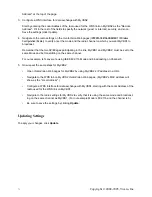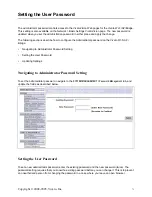
85
Copyright © 2004-2005, Vivato, Inc.
Creating and Managing Multiple Networks (SSIDs)
Each time an SSID is created, the AP/Bridge creates a new bridge that connects all of the selected
interfaces. The AP/Bridge comes with a default bridge (SSID) that cannot be deleted, which is referred to
as the "Primary Wireless Network" on the
Basic Settings
page. The IP address on that bridge is used to
access the VivatoVision web interfaces. Additional SSIDs are created and edited on the
SSID Configuration
VivatoVision page.
Radio interfaces can be shared by all bridges (SSIDs). However, an Ethernet port can only belong to one
bridge unless each SSID using that port is assigned to a different VLAN in order to differentiate the network
traffic from each SSID.Therefore, because the AP/Bridge has one Ethernet port,
only one SSID can be
created that does not use VLAN tagging
.
Using SSIDs with VLANs to Create Logically Separate Networks
VLANs provide a way to separate traffic from two or more SSIDs that share the same Ethernet port. Each
SSID is assigned a unique VLAN ID that a router or a switch configured for VLAN operation uses to
classify that traffic into a specific network.
In the following figure, two SSIDs were created that are assigned to VLANs. One SSID is called "Guest",
and is assigned to VLAN 2. The second SSID is called "Private", and is assigned to VLAN 3. Both SSIDs
are configured to use both radio interfaces and the same Ethernet port (Eth0). The network administrator
configures the router or switch to direct all packets tagged with VLAN 2 to an unsecured portal, whereas
packets tagged for VLAN 3 are forwarded to secure network servers..
Figure 5 Creating Two Separate Networks Using VLANs
Radio 0
Radio 1
Wireless Clients
Eth0
SSID Name: Guest
Security: Open
VLAN: 2
SSID Name: Private
Security: WPA
VLAN: 3
All packets
are tagged
for either
VLAN 2 or
VLAN 3,
and sent to
a VLAN
enabled
router or
switch.
















































